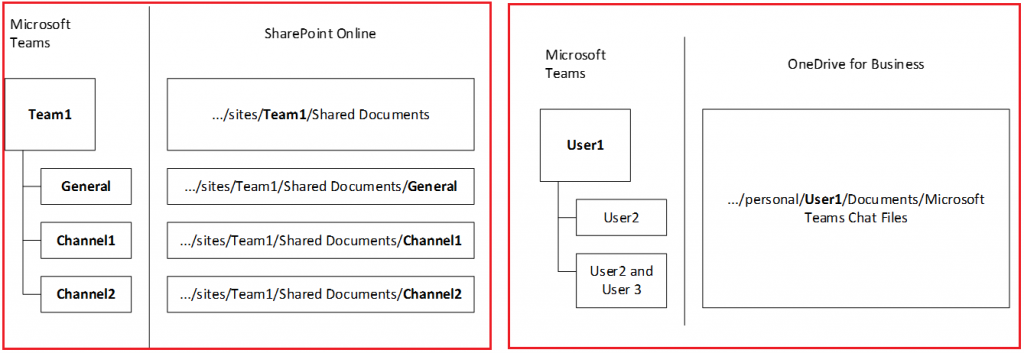Can you use Microsoft Teams without SharePoint?
I’ve heard variations on this question for a couple of years, and recently dipped my toes into a Yammer community discussion with people once again asking this question.
The short answer: No
The slightly longer answer: Microsoft says no.
The reason for the slightly longer answer: Microsoft Teams was architected to leverage existing Microsoft workloads. Specifically, when you create a team, a channel, or store files and documents, you’re using SharePoint (and OneDrive for Business). When you use chat or create a meeting, you’re using Exchange. In an October 2021 Q&A response, a Microsoft support person provided a very simple architectural diagram in response to this question to help illustrate:
It’s important to understand that SharePoint is not just a file repository that can be “swapped out” for any other document or file management platform (like Box, Google Drive, or Dropbox). It is an essential part of the platform that cannot be displaced. For organizations who are new to Teams and still using alternate cloud storage platforms, there are ways that you can integrate their usage as both tabs and within the files UX, which is a great way to continue to leverage these tools while your users transition, or for the long-term.
For a slightly more detailed description of the relationship between Microsoft Teams, Office 365 Groups, and SharePoint, check out this blog post by longtime friend and Information Management Practice Lead at Engage Squared, Andrew Jolly (@andrewjolly): Microsoft Teams and SharePoint permissions explained
Why people might be asking: It’s never the right thing to simply tell people (especially your end users / employees) NO without trying to understand the intent behind the request. If someone is asking a question that exceeds the capability of your current systems, or, as in this case, exceeds the scope of the underlying technology, try to understand why they are making the request. They may have legitimate business reasons for asking, and in some cases may not know how to best articulate that need. As my friend and fellow MVP John White (@diverdown1964) always says, “IT should not be the department of No.” That’s how shadow IT projects get started: someone has an unmet business need, and IT doesn’t seem to know how or want to help.
Why might someone want to use Microsoft Teams but not SharePoint?
- Your company is not quite ready to move forward with a full deployment of Teams, but wants to begin using the chat and meeting capabilities within Teams.
- You’ve been using Skype for Business and want to slowly transition to Teams, and not yet turn on all of its capabilities.
- For regulatory reasons, your company has concerns about using SharePoint and OneDrive for file sharing.
- Your company leverages another 3rd party solution for collaboration, but wants to make the transition to Teams over time, beginning with chat and meetings.
So….is it possible to deploy Teams without SharePoint?
Sort of. What you’re really doing is deploying Teams and restricting access and permissions to a small group of admins, greatly degrading the user experience for everyone else. Honestly, I’m not even sure of all of the impacts to the UX. Sometimes your end users will click on things, and it’ll give them an error message. Other times options may be grayed out. In short, you’ll be breaking the solution. BUT it can be done. It means disabling licenses for everyone except your admin team, and ensuring that nobody but this admin team can create new teams. You’ll also need to somehow disable the OOTB files experience to disable uploads via the Teams UX, as well as accessing these automatically-generated sites and libraries. I’m sure you can automate aspects of that, but it’s going to take some serious work.
Here’s some additional reading that may help you understand how to achieve these results, and the scope of what you’re changing:
- Overview of Teams and SharePoint integration, Microsoft
- Disabling Teams File Sharing and Disabling OneDrive for Office 365, Terence Luk
- How to disable download files and data from Teams, SharePoint and OneDrive and exchange online when user is logged in on personal devices? Microsoft Q&A
- Choose your upgrade journey from Skype for Business to Teams, Microsoft
- Why you should never disable Team Site creation in Office 365, SharePoint Maven
- How to Disable Microsoft Teams “Create a Team” Prompt in SharePoint Online? SharePoint Diary
Am I missing any scenarios? Would love to hear your feedback on this topic!





